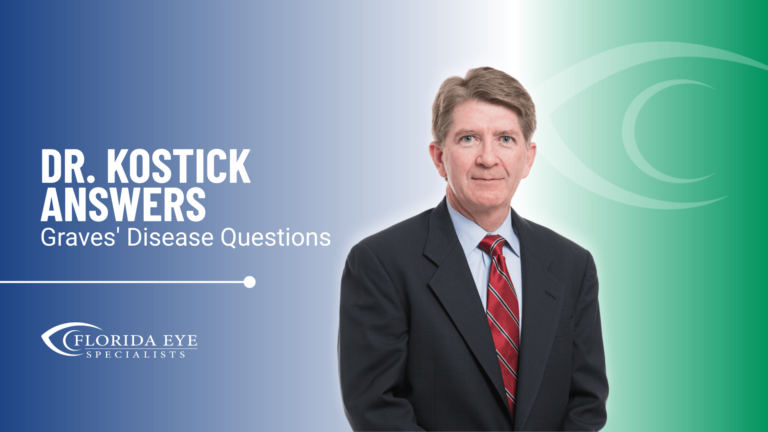Graves’ Disease affects nearly 1 in every 200 people. This autoimmune disorder is often accompanied by Graves’ Ophthalmopathy, also known as Thyroid Eye Disease (TED).
Florida Eye Specialists’ oculoplastic surgeon Dr. David Kostick, is one of a few specialists in the region with clinical experience treating TED with traditional and newly approved medical therapy. Below he offers insight on the importance of recognizing the symptoms of TED and how early treatment can drastically improve a patient’s quality of life.
How Do I Know I Have Graves’ Disease?
“Graves’ Disease is sometimes difficult to diagnose due to the varying symptoms that patients experience. The condition is an autoimmune disorder in which the body’s immune system may attack certain parts of the body, including the thyroid gland, the skin of the shin on the leg, and even the tissue behind the eye. Patients with Graves’ Disease commonly experience symptoms such as anxiety, hand tremors, heat sensitivity, weight loss, puffy eyes, and an enlarged thyroid.”
“While related, Graves’ Disease and TED are two separate conditions. Though the associated impact to the eye sockets is referred to as Thyroid Eye Disease, TED is not due to the abnormal, hyperactive thyroid attacking the eye, but rather the same condition that attacked the thyroid gland. About 20 to 50 percent of patients with Graves’ Disease will experience eye socket (orbital) involvement.”
What are Thyroid Eye Disease Symptoms?
“Thyroid Eye Disease (TED) can cause debilitating eye-related symptoms. TED is often characterized by inflammation of the tissue behind the eyes that can cause painful symptoms. Typical Thyroid Eye Disease symptoms include bulging eyes, eyelid retraction, difficulty closing eyes, eye redness, a dry and gritting feeling in the eyes, watery or teary eyes, and swelling of the eyelids or ocular surface. TED can also affect how the eyes move, causing double vision or misalignment in the eyes. Six percent of patients actually lose their vision from TED due to damage to the optic nerve. This is why early detection and treatment for TED is crucial.”
Why Should Patients Be Aware of These Illnesses and Their Symptoms?
“Early treatment of TED is critical to prevent the condition from progressing dangerously. Often, patients are affected by not only the physical impact to their eyes and vision, but also the emotional toll. The sometimes sudden and drastic change in appearance to a patient’s eyes can negatively impact quality of life, as patients retract from daily activities. Patients often become very self-conscious of their appearance and avoid activities that they enjoyed prior to being diagnosed with Graves’.”
“By being aware of the signs and symptoms of TED, patients can be treated early, giving doctors the opportunity to monitor their progression and avoid damage to the optic nerve.”
Are Graves’ Disease and Thyroid Eye Disease Treatable?
“In the past, there was no effective treatment available to prevent eye socket damage from Graves’ Disease. During the acute stage, doctors were resigned to monitoring patients to ensure they were not developing optic nerve damage. Then, typically after two or three years, the disease would reach the remission stage and stop progressing. It was not until the disease became stable that we could then offer reconstructive surgery. This surgery would often involve three separate surgeries: orbital decompression to reset the eyes back into the socket, eye muscle (strabismus) surgery to realign the eyes, and eyelid surgery to restore the normal position of the eyelids.”
“New breakthrough clinical studies have now given patients and doctors the option of medical therapy with Tepezza. Tepezza was FDA-approved in 2020 to treat Thyroid Eye Disease. Tepezza is a monoclonal antibody medication given intravenously every three weeks over the course of eight treatments. It works by preventing the circulating antibodies in Graves’ Disease from attaching to the eye socket tissue.”
“Studies have shown that 100 percent of patients receiving the medication stopped progressing and more than 80 percent had improvements in their proptosis (eye bulging). Since Tepezza stops the progression of the disease, it’s important to be aware of Graves’ Disease and Thyroid Eye Disease symptoms in order to be evaluated as soon as possible to prevent further damage.”
While there is no “cure” for Graves’ Disease, there are many treatments available. Are you looking for Graves’ Disease or Thyroid Eye Disease treatment? Schedule a consultation today with Dr. David A. Kostick to discuss your options.

